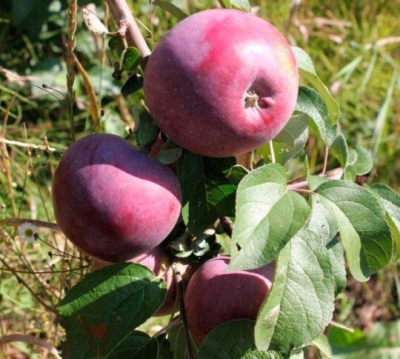
- Authors: Belarusian selection
- Taste: sweet and sour
- Scent: weak
- Fruit weight, g: 200
- Fruit size: large
- Yield: 25 t / ha
- Frequency of fruiting: annual
- The beginning of fruiting varieties: for 3-4 years
- Ripening terms: late winter
- Removable maturity: end of September
The Darunok apple tree is a fast-growing variety that allows you to get a rich harvest. This variety is distinguished by large fruits that can be eaten fresh, as well as used for homemade preserves, jams and other products.
Description of the variety
This species has an attractive appearance. It has a rich green color. The fruits have a bright ruddy color.
Features, pros and cons
The Darunok apple tree is the result of Belarusian selection. Created by scientists from the Institute of Fruit Growing, this variety is considered a rather promising late winter species that has increased resistance to fungal diseases.
In addition, Darunok has good commercial qualities of the fruit. It boasts high frost resistance. Trees can easily withstand the harshest winter conditions, as well as spring frosts.
This variety is capable of retaining all its consumer qualities for a long period. Darunok is a fast-growing apple tree. And also the main advantages, in addition to early maturity and winter hardiness, include ease of care. The variety has no significant drawbacks.
Ripening and fruiting
The variety is late winter, it has the longest shelf life of fruits. Ripe apples can be picked at the beginning of the fall season. Moreover, in most cases, they have just been removed from the tree and will not yet have consumer properties.
The aroma and taste will be revealed only after a few weeks, and sometimes even months. The variety is early-growing, it enters the fruiting period 3 or 4 years after planting.
Yield
The Darunok variety has a high yield level. So, if planting is carried out on a significant scale, then 25 tons can be harvested from one hectare of land. Ripe fruits begin to be removed from the trees in early autumn, and the harvest must be completed before the first frost.
Fruits and their taste
Ripe apples are rather large in size, the weight of one is about 200 grams. The fruits are round. They are all slightly ribbed.
Apples are most often green in color, with purple spots often on the surface. Their pulp is greenish, it has an average density, and this part of the variety is also fine-grained, juicy and aromatic.
The fruit tastes sweet and sour. Their shelf life can be up to 6 months.

Growing features
Planting the plant should be carried out in the spring season after warming up the soil. Moreover, 6 months before that, it will be necessary to dig holes 1 meter in size. One bucket of mullein is placed at the bottom of each such seat. All this is well sprinkled with loose earth.
Each young seedling will need to be inserted into the center of the planting pit.They are covered with soil and trampled down a little, then all this is abundantly watered to activate the roots.
In the first year after planting, it will be necessary to ensure the most frequent soil moisture in order to speed up the growing season. And also for this purpose it is better to periodically loosen and mulch the ground around the planted trees.
In the first year of growing an apple tree of this variety, it will not be necessary to add additional bait, the mullein, which was used for planting, is enough.
In the process of cultivation, one must not forget about the pruning (formative and sanitary). The first is aimed at forming a lush, regular crown. The second is designed to remove dead parts, it is carried out immediately after the descent of the snow masses. Correct removal of all excess branches will significantly increase yield levels.



Pollination
The Darunok variety is self-pollinating, so regardless of the presence of bees, the trees can easily pollinate themselves. At the same time, the ovary is formed annually, external factors have practically no effect on this, therefore the variety is very popular with gardeners.


Diseases and pests
Apple trees of this variety can boast of special resistance to a wide variety of diseases and pests. But at the same time, problems can still arise during rainy periods.
Powdery mildew often begins to develop due to excessive moisture levels. In this case, the most effective way to combat it is a thorough treatment with sulfur preparations.
And also sometimes apple trees are affected by scab, which is why spots of brown color with a bloom begin to appear on the leaves. In this case, it is best to use Bordeaux liquid.
Sometimes damage on trunks or on leaf blades only signals a lack of nutritional components. So, the leaves can turn yellow due to a lack of iron. And also they can be deformed, the veins often turn green.
Often Darunok is affected by ticks. The sheet plates are strongly deformed, and then fall off.All fallen leaves must be immediately removed from the site and burned. The near-trunk circle is then well dug up, and pruning is also carried out.
In winter, young apple trees can be damaged by small rodents and hares. To avoid this, it is better to tightly wrap the trunks with spruce branches, sometimes dried sunflower stems are also used. At the same time, there should not be even small gaps on the surface of the seedlings.

The apple tree is a popular fruit crop among gardeners. It can be found in many summer cottages. But at the same time, such trees are often affected by various diseases. It is very important to recognize the disease in time and carry out the necessary procedures for a speedy recovery. Otherwise, the fruits will be spoiled, and the tree itself may die altogether.












































































